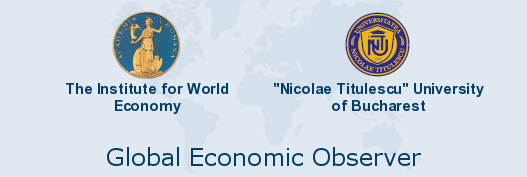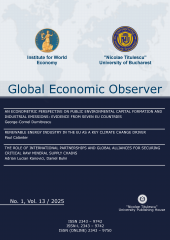AUTHOR GUIDELINES
1. General provisions
Publishing is free of charge. The journal has no article processing charges and no article submission charges.
The editors welcome for review original papers looking at any aspect of the global economy and the international economic relations. The main criterion for acceptance is for the papers to make a contribution to the knowledge, understanding and / or practice in their specific field.
Global Economic Observer will not accept an article if it’s not the Author’s original work, if it has been published before, in English, or if it is currently under consideration for publication elsewhere. However, original articles previously published only in Romanian could be accepted in their English version if they comply with the other GEO requirements.
On acceptance of your manuscript, you will be required to sign a warranty that your manuscript is original and has not been submitted for publication or published elsewhere.
All articles must be written in English, preferably British. Authors for whom English is not their first language are asked to call on an English-speaking colleague to proofread their article before submitting it to Global Economic Observer.
Plagiarism in any of its forms or any other academic fraud will not be tolerated. Examples include:
– word-for-word copying of another author’s writings, without quotation marks and proper acknowledging of the source;
– the paraphrasing or the re-statement of another author’s ideas without acknowledging the paternity of those ideas;
– the use of a particular concept or term coined by another author, without mentioning him and/or the source;
– false citations;
– False or fabricated data.
If, for any reason, the Author wishes to abandon the peer review process at Global Economic Observer and submit his / her article somewhere else, he /she should formally withdraw it in written from Global Economic Observer, before submitting it to another journal.
2. Manuscript preparation
Template: download here.
Articles should be submitted electronically in one-column format, with a word count of maximum 5000 (between 6 and 10 pages), Times New Roman, font 11 for the text proper, 16 for the title and 14 for the sub-titles. You need to have A4-sized pages (21 x 29 cm) pages with top and bottom margins of 2.5 cm and left and right margins of 1.8 cm. Use single space.
For the words Abstract, Key-Words and References Italics. Ensure that the text on the final page is spread so that both columns finish at the same distance from the top of the page.
An article which would exceed 5000 words or occupy more than 10 pages of the journal may be returned for abridgement. Articles may include one of the following: empirical research, conceptual models, theory building, innovative methodologies and applications, case studies. All articles undergo rigorous peer review, with initial editor screening followed by blind-reviewing, normally by two referees.
Opinion pieces should be between 1000 and 1500 words. Responses to opinion pieces are encouraged. Opinion pieces are reviewed by members of the Editorial Team.
Book reviews should be between 1500 and 2000 words, exploring the implications of the book to the research / practice field, from the reviewer’s perspective.
Articles should include:
TITLE – as short as possible, with no abbreviations or acronyms (centered, bold, Times, 16, CAPS LOCK);
AUTHORS’ NAMES (Capital, 12pt Times New Roman, centered)
Department (12pt Times New Roman, centered)
University (12pt Times New Roman, centered)
Address (12pt Times New Roman, centered)
COUNTRY (Capital, 12pt Times New Roman, centered)
youremailaccount@xxx.xxx.xx http://www.yourwebaddress.xx (12pt Times New Roman, centered)
Abstract (Times, italic, 11)
No more than 300 words. The abstract must clearly specify the purpose of the paper and the objectives pursued by the author by his/her study. (Times, 11)
Key-Words (Times, italic, 11)
Leave one blank line after the Abstract and write your Key-Words (6 – 10 words). They should include all the essential words from the title and the abstract. Acronyms should be mentioned also in full version, without any brackets. (Times, 11, italic).
Introduction (Times, bold, 14)
The introduction shall have a page at the most, however not less than half a page. The text must provide answers for four questions. (1) What matter does the paper cover? (2) Why is the studied matter important? (3) How does the author intend to answer to this matter? (4) What is the relation between the paper and the already existent specialized literature? This introductory section shall be written clearly, and any confusion in communicating the four answers might result in paper rejection. (Times, 11)
Text (headline depending on the specific of the approach subject) (Times, bold, 14)
In this section the author must present and argue his/her research outcomes. The author is free to choose the structure of his/her paper content depending on the specific of the approached subject. (Times, 11)
FIGURES. ACQUIRING PERMISSION FOR COPYRIGHTED IMAGES. It is the Authors’ responsibility to obtain written permission for any copyrighted images included in their manuscripts, whether they are screenshots, figures, tables, graphics, etc. They are responsible for indicating the original source of the image and that it is being used with permission. Should the Authors create an image that is loosely based on another copyrighted image, they must indicate that it was adapted from another copyrighted image and provide the original source. All Figures and Tables must be black & white with titles of 11pt, centered, bold Times New Roman.
Conclusions (Times, bold, 14)
The conclusions section shall cover three elements: (1) it shall summarize the main outcomes; (2) it shall present the expected impact of the research outcomes; (3) it shall include suggestions for further research work. (Times, 11)
REFERENCES AND NOTES. Global Economic Observer uses the Harvard (name and date) short reference system for citations in the text with a detailed alphabetical list at the end of the article.
Footnotes should be avoided.
Full reference at the end of the article, in alphabetical order by author, should include all authors’ names and initials, the date of publication, the title of the article, the title of the publication (italics), volume and issue number (of a journal), publisher and form (books, conference proceedings), page numbers. Where there is more than one reference from the same author(s) in the same year, references should be identified by suffix letters e.g. (Pearce, 1995a).
In-text citations
When citing a source in your text, you will need to state the authors’ surnames along with the year of publication. Please note the following:
- If you have several references cited within the same parenthesis, the citations should be listed in alphabetical order. You’ll note that 1) each citation is separated by a semicolon, and 2) ampersands (&) are used instead of the word “and.”
- Example: In most organizations, data resources are considered to be a major resource (Brown, 2002; Krall & Johnson, 2005; Smith, 2001).
- If an author’s name is mentioned directly in the text of the manuscript as part of a sentence, please note that only the year is placed within parenthesis.
- Example: Brown (2002) states that the value of data is recognized by most organizations.
- If you directly quote another individual’s work, you must also provide the page of the source from which the quote was taken.
- Example: “In most organizations, data resources are considered to be a major organization asset” (Smith, 2001, pp. 35-36) and must be carefully monitored by the senior management.
- Example: Brown (2002) states that “the value of data is realized by most organizations” (p. 45).
- If a direct quote that you wish to include in your manuscriptis more than 40 words long, please be sure to format your quote as a block quote (a block quote uses no quotation marks, and its margins are indented from the left; also, you’ll notice that the period at the end of the sentence comes before the parenthetical in-text citation):
- Example: As an ever-growing number of people around the world have gained access to e-mail and Internet facilities, it has become clear that the communicative environment provided by these tools can foster language learning. E-mail facilitates access to speakers of one’s target language. (Vinagre & Lera, 2007, p. 35)
References
– Book with one author: Author, A. A. (2005). Title of work. Location/City, State: Publisher.
– Book with two authors: Author, A. A., & Author, B. B. (2005). Title of work. Location/City, State: Publisher.
– Book with more than two authors: Author, A. A., Author, B. B., & Author, C. C. (2005). Title of work. Location/City, State: Publisher.
– Journal article: Sawyer, S., & Tapia, A. (2005). The sociotechnical nature of mobile computing work: Evidence from a study of policing in the United States. International Journal of Technology and Human Interaction, 1(3), 1-14.
– A publication in press: Junho, S. (in press). Roadmap for e-commerce standardization in Korea. International Journal of IT Standards and Standardization Research.
– Edited book: Zhao, F. (Ed.). (2006). Maximize business profits through e-partnerships. Hershey, PA: IRM Press.
– Chapter in an edited book: Jaques, P. A., & Viccari, R. M. (2006). Considering students’ emotions in computer-mediated learning environments. In Z. Ma (Ed.), Web-based intelligent e-learning systems: Technologies and applications (pp. 122-138). Hershey, PA: Information Science Publishing.
– Report from an university: Broadhurst, R. G., & Maller, R. A. (1991). Sex offending and recidivism (Tech. Rep. No. 3). Nedlands, Western Australia: University of Western Australia, Crime Research Centre.
– Published proceedings: Deci, E. L., & Ryan, R. M. (1991). A motivational approach to self: Integration in personality. In R. Dienstbier (Ed.), NebraskaSymposium on Motivation: Vol. 38. Perspectives on motivation (pp. 237-288). Lincoln: University of Nebraska Press.
– Unpublished doctoral dissertation or master’s thesis: Wilfley, D. (1989). Interpersonal analyses of bulimia: Normal-weight and obese. Unpublished doctoral dissertation, University of Missouri, Columbia.
– A presented paper: Lanktree, C., & Briere, J. (1991, January). Early data on the Trauma Symptom Checklist for Children (TSC-C). Paper presented at the meeting of the American Professional Society on the Abuse of Children, San Diego, CA.
– Web site: VandenBos, G., Knapp, S., & Doe, J. (2001). Role of reference elements in the selection of resources by psychology undergraduates. Journal of Bibliographic Research, 5, 117-123. Retrieved October 13, 2001, from http://jbr.org/articles.html
– Units of Measurement. Global Economic Observer follows the International System (SI) for Units of measurement. Imperial units will be converted to SI units.
Manuscripts should be emailed to the Editor at globeco@univnt.ro as a file attachment in Microsoft® Word. The main body of the e-mail message should contain the title of the paper and the names and addresses of all authors. Please note that the names of the author / co-authors should not be included anywhere in the manuscript, except on the cover page.
Copy editing
The editor reserves the right to copy edit submissions to fit journal style and approach.

